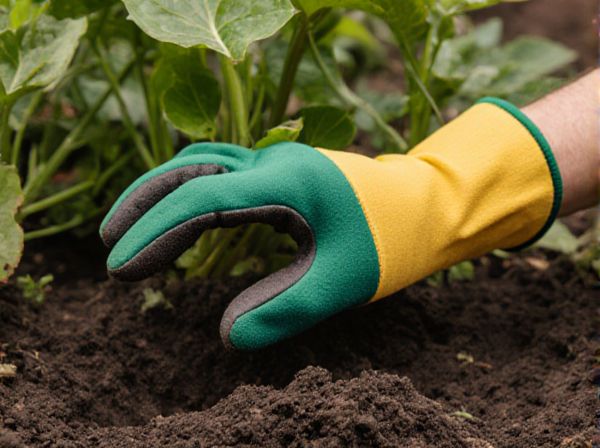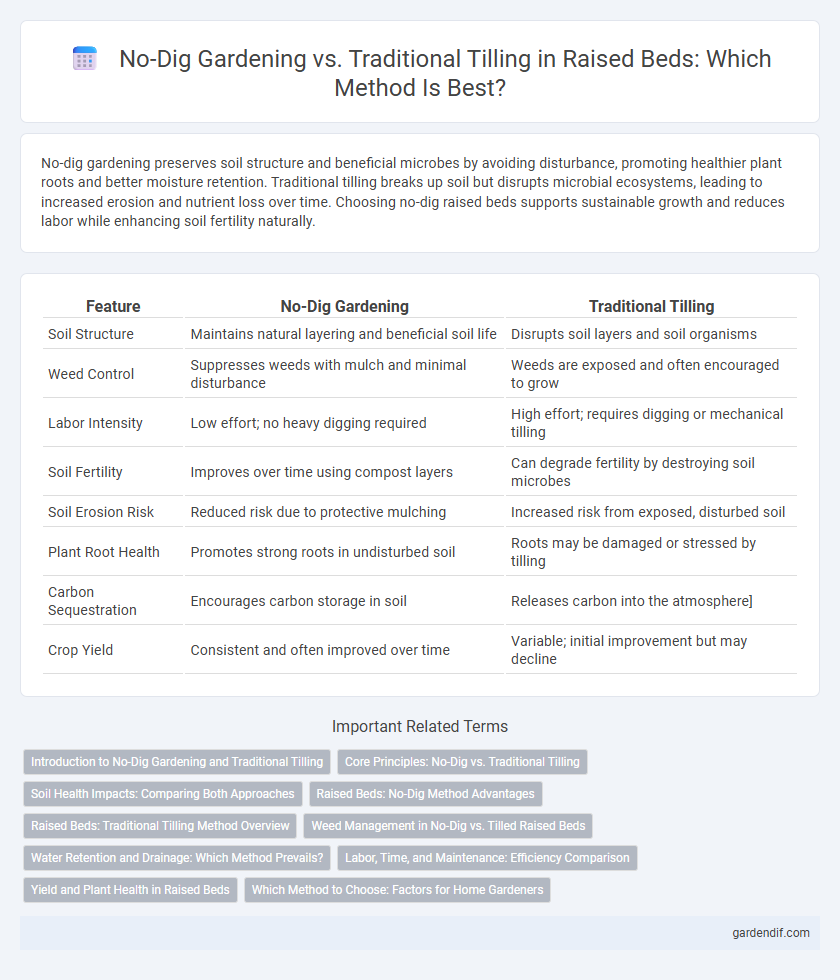
No-dig gardening vs Traditional tilling Illustration
No-dig gardening preserves soil structure and beneficial microbes by avoiding disturbance, promoting healthier plant roots and better moisture retention. Traditional tilling breaks up soil but disrupts microbial ecosystems, leading to increased erosion and nutrient loss over time. Choosing no-dig raised beds supports sustainable growth and reduces labor while enhancing soil fertility naturally.
Table of Comparison
| Feature | No-Dig Gardening | Traditional Tilling |
|---|---|---|
| Soil Structure | Maintains natural layering and beneficial soil life | Disrupts soil layers and soil organisms |
| Weed Control | Suppresses weeds with mulch and minimal disturbance | Weeds are exposed and often encouraged to grow |
| Labor Intensity | Low effort; no heavy digging required | High effort; requires digging or mechanical tilling |
| Soil Fertility | Improves over time using compost layers | Can degrade fertility by destroying soil microbes |
| Soil Erosion Risk | Reduced risk due to protective mulching | Increased risk from exposed, disturbed soil |
| Plant Root Health | Promotes strong roots in undisturbed soil | Roots may be damaged or stressed by tilling |
| Carbon Sequestration | Encourages carbon storage in soil | Releases carbon into the atmosphere] |
| Crop Yield | Consistent and often improved over time | Variable; initial improvement but may decline |
Introduction to No-Dig Gardening and Traditional Tilling
No-dig gardening preserves soil structure and microbial life by layering organic matter without disturbing the earth, promoting healthy plant growth and reducing weed problems. Traditional tilling involves turning and breaking up the soil to prepare garden beds, which can improve aeration but often disrupts natural soil ecosystems and accelerates erosion. Both methods influence soil health and plant productivity differently, making the choice essential for sustainable garden management.
Core Principles: No-Dig vs. Traditional Tilling
No-dig gardening preserves soil structure by maintaining organic matter on the surface, promoting microbial activity and natural soil aeration, while traditional tilling disrupts soil layers, leading to erosion and loss of beneficial organisms. Core principles of no-dig focus on minimal disturbance and fostering a healthy ecosystem, whereas traditional tilling emphasizes mechanical soil turnover to prepare seedbeds. Optimizing soil health through no-dig methods enhances moisture retention and nutrient cycling, contrasting with the often short-term soil fertility gains and long-term degradation risks posed by tilling.
Soil Health Impacts: Comparing Both Approaches
No-dig gardening preserves soil structure by minimizing disturbance, promoting beneficial microbial activity and earthworm populations essential for nutrient cycling. Traditional tilling disrupts soil aggregates, accelerates organic matter decomposition, and can lead to erosion and compaction over time. Studies show no-dig methods enhance soil carbon retention and moisture retention, fostering sustainable soil health compared to conventional tillage practices.
Raised Beds: No-Dig Method Advantages
The no-dig method in raised bed gardening preserves soil structure and beneficial microorganisms by avoiding disturbance, promoting healthier plant growth. This approach reduces weed emergence and maintains moisture retention better than traditional tilling, resulting in less labor and water usage. Raised beds using the no-dig technique enhance nutrient cycling and improve soil fertility over time, leading to more sustainable and productive garden ecosystems.
Raised Beds: Traditional Tilling Method Overview
Traditional tilling involves turning and breaking up soil to prepare garden beds for planting, often disrupting soil structure and microbial life. Raised beds created using this method require intensive labor to loosen compacted soil and incorporate organic matter evenly. While tilling can improve initial soil aeration, repeated disturbance may lead to erosion and nutrient depletion compared to no-dig gardening.
Weed Management in No-Dig vs. Tilled Raised Beds
No-dig gardening in raised beds significantly reduces weed growth by preserving intact soil structure and microbial communities that naturally suppress weed seeds. Traditional tilling disturbs the soil, bringing dormant weed seeds to the surface and encouraging their germination, leading to increased weed pressure. Maintaining a mulch layer in no-dig beds further inhibits weed emergence by blocking sunlight and creating unfavorable conditions for weed seed sprouting.
Water Retention and Drainage: Which Method Prevails?
No-dig gardening enhances water retention by preserving soil structure and organic matter, which improves moisture absorption and reduces runoff. Traditional tilling disrupts soil layers, often leading to faster drainage but increased evaporation and nutrient leaching. In terms of maintaining balanced moisture levels, no-dig gardening generally prevails due to its ability to retain water while supporting healthy root systems.
Labor, Time, and Maintenance: Efficiency Comparison
No-dig gardening significantly reduces labor by eliminating the need for soil turning, which preserves soil structure and minimizes physical effort. Time efficiency is enhanced as no-dig beds require less frequent soil preparation and maintain healthier organic layers, accelerating plant growth cycles. Maintenance demands are lower due to reduced weed proliferation and improved moisture retention, making no-dig methods more sustainable compared to traditional tilling.
Yield and Plant Health in Raised Beds
No-dig gardening in raised beds promotes higher yield and improved plant health by preserving soil structure and microbial life, resulting in enhanced nutrient availability and root development. Traditional tilling disrupts soil ecosystems, often leading to nutrient loss and increased weed growth, which can negatively impact crop productivity. Studies show no-dig methods increase beneficial soil organisms and moisture retention, directly supporting stronger, more resilient plants.
Which Method to Choose: Factors for Home Gardeners
Home gardeners should consider soil health, labor intensity, and long-term sustainability when choosing between no-dig gardening and traditional tilling. No-dig gardening preserves soil structure, enhances microbial activity, and reduces erosion, making it ideal for promoting robust plant growth with minimal soil disturbance. Traditional tilling may improve initial soil aeration but can lead to soil degradation and increased weed growth, requiring more frequent maintenance.
No-dig gardening vs Traditional tilling Infographic

 gardendif.com
gardendif.com